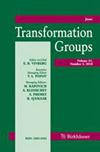求助PDF
{"title":"基本经典李超代数中幂零元的中心中心","authors":"Leyu Han","doi":"10.1007/s00031-023-09814-3","DOIUrl":null,"url":null,"abstract":"Abstract Let $$\\mathfrak {g}=\\mathfrak {g}_{\\bar{0}}\\oplus \\mathfrak {g}_{\\bar{1}}$$ <mml:math xmlns:mml=\"http://www.w3.org/1998/Math/MathML\"> <mml:mrow> <mml:mi>g</mml:mi> <mml:mo>=</mml:mo> <mml:msub> <mml:mi>g</mml:mi> <mml:mover> <mml:mrow> <mml:mn>0</mml:mn> </mml:mrow> <mml:mrow> <mml:mo>¯</mml:mo> </mml:mrow> </mml:mover> </mml:msub> <mml:mo>⊕</mml:mo> <mml:msub> <mml:mi>g</mml:mi> <mml:mover> <mml:mrow> <mml:mn>1</mml:mn> </mml:mrow> <mml:mrow> <mml:mo>¯</mml:mo> </mml:mrow> </mml:mover> </mml:msub> </mml:mrow> </mml:math> be a basic classical Lie superalgebra over an algebraically closed field $$\\mathbb {K}$$ <mml:math xmlns:mml=\"http://www.w3.org/1998/Math/MathML\"> <mml:mi>K</mml:mi> </mml:math> whose characteristic $$p>0$$ <mml:math xmlns:mml=\"http://www.w3.org/1998/Math/MathML\"> <mml:mrow> <mml:mi>p</mml:mi> <mml:mo>></mml:mo> <mml:mn>0</mml:mn> </mml:mrow> </mml:math> is a good prime for $$\\mathfrak {g}$$ <mml:math xmlns:mml=\"http://www.w3.org/1998/Math/MathML\"> <mml:mi>g</mml:mi> </mml:math> . Let $$G_{\\bar{0}}$$ <mml:math xmlns:mml=\"http://www.w3.org/1998/Math/MathML\"> <mml:msub> <mml:mi>G</mml:mi> <mml:mover> <mml:mrow> <mml:mn>0</mml:mn> </mml:mrow> <mml:mrow> <mml:mo>¯</mml:mo> </mml:mrow> </mml:mover> </mml:msub> </mml:math> be the reductive algebraic group over $$\\mathbb {K}$$ <mml:math xmlns:mml=\"http://www.w3.org/1998/Math/MathML\"> <mml:mi>K</mml:mi> </mml:math> such that $$\\textrm{Lie}(G_{\\bar{0}})=\\mathfrak {g}_{\\bar{0}}$$ <mml:math xmlns:mml=\"http://www.w3.org/1998/Math/MathML\"> <mml:mrow> <mml:mtext>Lie</mml:mtext> <mml:mrow> <mml:mo>(</mml:mo> <mml:msub> <mml:mi>G</mml:mi> <mml:mover> <mml:mrow> <mml:mn>0</mml:mn> </mml:mrow> <mml:mrow> <mml:mo>¯</mml:mo> </mml:mrow> </mml:mover> </mml:msub> <mml:mo>)</mml:mo> </mml:mrow> <mml:mo>=</mml:mo> <mml:msub> <mml:mi>g</mml:mi> <mml:mover> <mml:mrow> <mml:mn>0</mml:mn> </mml:mrow> <mml:mrow> <mml:mo>¯</mml:mo> </mml:mrow> </mml:mover> </mml:msub> </mml:mrow> </mml:math> . Suppose $$e\\in \\mathfrak {g}_{\\bar{0}}$$ <mml:math xmlns:mml=\"http://www.w3.org/1998/Math/MathML\"> <mml:mrow> <mml:mi>e</mml:mi> <mml:mo>∈</mml:mo> <mml:msub> <mml:mi>g</mml:mi> <mml:mover> <mml:mrow> <mml:mn>0</mml:mn> </mml:mrow> <mml:mrow> <mml:mo>¯</mml:mo> </mml:mrow> </mml:mover> </mml:msub> </mml:mrow> </mml:math> is nilpotent. Write $$\\mathfrak {g}^{e}$$ <mml:math xmlns:mml=\"http://www.w3.org/1998/Math/MathML\"> <mml:msup> <mml:mrow> <mml:mi>g</mml:mi> </mml:mrow> <mml:mi>e</mml:mi> </mml:msup> </mml:math> for the centralizer of e in $$\\mathfrak {g}$$ <mml:math xmlns:mml=\"http://www.w3.org/1998/Math/MathML\"> <mml:mi>g</mml:mi> </mml:math> and $$\\mathfrak {z}(\\mathfrak {g}^{e})$$ <mml:math xmlns:mml=\"http://www.w3.org/1998/Math/MathML\"> <mml:mrow> <mml:mi>z</mml:mi> <mml:mo>(</mml:mo> <mml:msup> <mml:mrow> <mml:mi>g</mml:mi> </mml:mrow> <mml:mi>e</mml:mi> </mml:msup> <mml:mo>)</mml:mo> </mml:mrow> </mml:math> for the centre of $$\\mathfrak {g}^{e}$$ <mml:math xmlns:mml=\"http://www.w3.org/1998/Math/MathML\"> <mml:msup> <mml:mrow> <mml:mi>g</mml:mi> </mml:mrow> <mml:mi>e</mml:mi> </mml:msup> </mml:math> . We calculate a basis for $$\\mathfrak {g}^{e}$$ <mml:math xmlns:mml=\"http://www.w3.org/1998/Math/MathML\"> <mml:msup> <mml:mrow> <mml:mi>g</mml:mi> </mml:mrow> <mml:mi>e</mml:mi> </mml:msup> </mml:math> and $$\\mathfrak {z}(\\mathfrak {g}^{e})$$ <mml:math xmlns:mml=\"http://www.w3.org/1998/Math/MathML\"> <mml:mrow> <mml:mi>z</mml:mi> <mml:mo>(</mml:mo> <mml:msup> <mml:mrow> <mml:mi>g</mml:mi> </mml:mrow> <mml:mi>e</mml:mi> </mml:msup> <mml:mo>)</mml:mo> </mml:mrow> </mml:math> by using associated cocharacters $$\\tau :\\mathbb {K}^{\\times }\\rightarrow G_{\\bar{0}}$$ <mml:math xmlns:mml=\"http://www.w3.org/1998/Math/MathML\"> <mml:mrow> <mml:mi>τ</mml:mi> <mml:mo>:</mml:mo> <mml:msup> <mml:mrow> <mml:mi>K</mml:mi> </mml:mrow> <mml:mo>×</mml:mo> </mml:msup> <mml:mo>→</mml:mo> <mml:msub> <mml:mi>G</mml:mi> <mml:mover> <mml:mrow> <mml:mn>0</mml:mn> </mml:mrow> <mml:mrow> <mml:mo>¯</mml:mo> </mml:mrow> </mml:mover> </mml:msub> </mml:mrow> </mml:math> of e . In addition, we give the classification of e which are reachable, strongly reachable or satisfy the Panyushev property for exceptional Lie superalgebras $$D(2,1;\\alpha )$$ <mml:math xmlns:mml=\"http://www.w3.org/1998/Math/MathML\"> <mml:mrow> <mml:mi>D</mml:mi> <mml:mo>(</mml:mo> <mml:mn>2</mml:mn> <mml:mo>,</mml:mo> <mml:mn>1</mml:mn> <mml:mo>;</mml:mo> <mml:mi>α</mml:mi> <mml:mo>)</mml:mo> </mml:mrow> </mml:math> , G (3) and F (4).","PeriodicalId":49423,"journal":{"name":"Transformation Groups","volume":"1 1","pages":"0"},"PeriodicalIF":0.4000,"publicationDate":"2023-09-12","publicationTypes":"Journal Article","fieldsOfStudy":null,"isOpenAccess":false,"openAccessPdf":"","citationCount":"0","resultStr":"{\"title\":\"Centralizers of Nilpotent Elements in Basic Classical Lie Superalgebras in Good Characteristic\",\"authors\":\"Leyu Han\",\"doi\":\"10.1007/s00031-023-09814-3\",\"DOIUrl\":null,\"url\":null,\"abstract\":\"Abstract Let $$\\\\mathfrak {g}=\\\\mathfrak {g}_{\\\\bar{0}}\\\\oplus \\\\mathfrak {g}_{\\\\bar{1}}$$ <mml:math xmlns:mml=\\\"http://www.w3.org/1998/Math/MathML\\\"> <mml:mrow> <mml:mi>g</mml:mi> <mml:mo>=</mml:mo> <mml:msub> <mml:mi>g</mml:mi> <mml:mover> <mml:mrow> <mml:mn>0</mml:mn> </mml:mrow> <mml:mrow> <mml:mo>¯</mml:mo> </mml:mrow> </mml:mover> </mml:msub> <mml:mo>⊕</mml:mo> <mml:msub> <mml:mi>g</mml:mi> <mml:mover> <mml:mrow> <mml:mn>1</mml:mn> </mml:mrow> <mml:mrow> <mml:mo>¯</mml:mo> </mml:mrow> </mml:mover> </mml:msub> </mml:mrow> </mml:math> be a basic classical Lie superalgebra over an algebraically closed field $$\\\\mathbb {K}$$ <mml:math xmlns:mml=\\\"http://www.w3.org/1998/Math/MathML\\\"> <mml:mi>K</mml:mi> </mml:math> whose characteristic $$p>0$$ <mml:math xmlns:mml=\\\"http://www.w3.org/1998/Math/MathML\\\"> <mml:mrow> <mml:mi>p</mml:mi> <mml:mo>></mml:mo> <mml:mn>0</mml:mn> </mml:mrow> </mml:math> is a good prime for $$\\\\mathfrak {g}$$ <mml:math xmlns:mml=\\\"http://www.w3.org/1998/Math/MathML\\\"> <mml:mi>g</mml:mi> </mml:math> . Let $$G_{\\\\bar{0}}$$ <mml:math xmlns:mml=\\\"http://www.w3.org/1998/Math/MathML\\\"> <mml:msub> <mml:mi>G</mml:mi> <mml:mover> <mml:mrow> <mml:mn>0</mml:mn> </mml:mrow> <mml:mrow> <mml:mo>¯</mml:mo> </mml:mrow> </mml:mover> </mml:msub> </mml:math> be the reductive algebraic group over $$\\\\mathbb {K}$$ <mml:math xmlns:mml=\\\"http://www.w3.org/1998/Math/MathML\\\"> <mml:mi>K</mml:mi> </mml:math> such that $$\\\\textrm{Lie}(G_{\\\\bar{0}})=\\\\mathfrak {g}_{\\\\bar{0}}$$ <mml:math xmlns:mml=\\\"http://www.w3.org/1998/Math/MathML\\\"> <mml:mrow> <mml:mtext>Lie</mml:mtext> <mml:mrow> <mml:mo>(</mml:mo> <mml:msub> <mml:mi>G</mml:mi> <mml:mover> <mml:mrow> <mml:mn>0</mml:mn> </mml:mrow> <mml:mrow> <mml:mo>¯</mml:mo> </mml:mrow> </mml:mover> </mml:msub> <mml:mo>)</mml:mo> </mml:mrow> <mml:mo>=</mml:mo> <mml:msub> <mml:mi>g</mml:mi> <mml:mover> <mml:mrow> <mml:mn>0</mml:mn> </mml:mrow> <mml:mrow> <mml:mo>¯</mml:mo> </mml:mrow> </mml:mover> </mml:msub> </mml:mrow> </mml:math> . Suppose $$e\\\\in \\\\mathfrak {g}_{\\\\bar{0}}$$ <mml:math xmlns:mml=\\\"http://www.w3.org/1998/Math/MathML\\\"> <mml:mrow> <mml:mi>e</mml:mi> <mml:mo>∈</mml:mo> <mml:msub> <mml:mi>g</mml:mi> <mml:mover> <mml:mrow> <mml:mn>0</mml:mn> </mml:mrow> <mml:mrow> <mml:mo>¯</mml:mo> </mml:mrow> </mml:mover> </mml:msub> </mml:mrow> </mml:math> is nilpotent. Write $$\\\\mathfrak {g}^{e}$$ <mml:math xmlns:mml=\\\"http://www.w3.org/1998/Math/MathML\\\"> <mml:msup> <mml:mrow> <mml:mi>g</mml:mi> </mml:mrow> <mml:mi>e</mml:mi> </mml:msup> </mml:math> for the centralizer of e in $$\\\\mathfrak {g}$$ <mml:math xmlns:mml=\\\"http://www.w3.org/1998/Math/MathML\\\"> <mml:mi>g</mml:mi> </mml:math> and $$\\\\mathfrak {z}(\\\\mathfrak {g}^{e})$$ <mml:math xmlns:mml=\\\"http://www.w3.org/1998/Math/MathML\\\"> <mml:mrow> <mml:mi>z</mml:mi> <mml:mo>(</mml:mo> <mml:msup> <mml:mrow> <mml:mi>g</mml:mi> </mml:mrow> <mml:mi>e</mml:mi> </mml:msup> <mml:mo>)</mml:mo> </mml:mrow> </mml:math> for the centre of $$\\\\mathfrak {g}^{e}$$ <mml:math xmlns:mml=\\\"http://www.w3.org/1998/Math/MathML\\\"> <mml:msup> <mml:mrow> <mml:mi>g</mml:mi> </mml:mrow> <mml:mi>e</mml:mi> </mml:msup> </mml:math> . We calculate a basis for $$\\\\mathfrak {g}^{e}$$ <mml:math xmlns:mml=\\\"http://www.w3.org/1998/Math/MathML\\\"> <mml:msup> <mml:mrow> <mml:mi>g</mml:mi> </mml:mrow> <mml:mi>e</mml:mi> </mml:msup> </mml:math> and $$\\\\mathfrak {z}(\\\\mathfrak {g}^{e})$$ <mml:math xmlns:mml=\\\"http://www.w3.org/1998/Math/MathML\\\"> <mml:mrow> <mml:mi>z</mml:mi> <mml:mo>(</mml:mo> <mml:msup> <mml:mrow> <mml:mi>g</mml:mi> </mml:mrow> <mml:mi>e</mml:mi> </mml:msup> <mml:mo>)</mml:mo> </mml:mrow> </mml:math> by using associated cocharacters $$\\\\tau :\\\\mathbb {K}^{\\\\times }\\\\rightarrow G_{\\\\bar{0}}$$ <mml:math xmlns:mml=\\\"http://www.w3.org/1998/Math/MathML\\\"> <mml:mrow> <mml:mi>τ</mml:mi> <mml:mo>:</mml:mo> <mml:msup> <mml:mrow> <mml:mi>K</mml:mi> </mml:mrow> <mml:mo>×</mml:mo> </mml:msup> <mml:mo>→</mml:mo> <mml:msub> <mml:mi>G</mml:mi> <mml:mover> <mml:mrow> <mml:mn>0</mml:mn> </mml:mrow> <mml:mrow> <mml:mo>¯</mml:mo> </mml:mrow> </mml:mover> </mml:msub> </mml:mrow> </mml:math> of e . In addition, we give the classification of e which are reachable, strongly reachable or satisfy the Panyushev property for exceptional Lie superalgebras $$D(2,1;\\\\alpha )$$ <mml:math xmlns:mml=\\\"http://www.w3.org/1998/Math/MathML\\\"> <mml:mrow> <mml:mi>D</mml:mi> <mml:mo>(</mml:mo> <mml:mn>2</mml:mn> <mml:mo>,</mml:mo> <mml:mn>1</mml:mn> <mml:mo>;</mml:mo> <mml:mi>α</mml:mi> <mml:mo>)</mml:mo> </mml:mrow> </mml:math> , G (3) and F (4).\",\"PeriodicalId\":49423,\"journal\":{\"name\":\"Transformation Groups\",\"volume\":\"1 1\",\"pages\":\"0\"},\"PeriodicalIF\":0.4000,\"publicationDate\":\"2023-09-12\",\"publicationTypes\":\"Journal Article\",\"fieldsOfStudy\":null,\"isOpenAccess\":false,\"openAccessPdf\":\"\",\"citationCount\":\"0\",\"resultStr\":null,\"platform\":\"Semanticscholar\",\"paperid\":null,\"PeriodicalName\":\"Transformation Groups\",\"FirstCategoryId\":\"1085\",\"ListUrlMain\":\"https://doi.org/10.1007/s00031-023-09814-3\",\"RegionNum\":3,\"RegionCategory\":\"数学\",\"ArticlePicture\":[],\"TitleCN\":null,\"AbstractTextCN\":null,\"PMCID\":null,\"EPubDate\":\"\",\"PubModel\":\"\",\"JCR\":\"Q4\",\"JCRName\":\"MATHEMATICS\",\"Score\":null,\"Total\":0}","platform":"Semanticscholar","paperid":null,"PeriodicalName":"Transformation Groups","FirstCategoryId":"1085","ListUrlMain":"https://doi.org/10.1007/s00031-023-09814-3","RegionNum":3,"RegionCategory":"数学","ArticlePicture":[],"TitleCN":null,"AbstractTextCN":null,"PMCID":null,"EPubDate":"","PubModel":"","JCR":"Q4","JCRName":"MATHEMATICS","Score":null,"Total":0}
引用次数: 0
引用
批量引用
Centralizers of Nilpotent Elements in Basic Classical Lie Superalgebras in Good Characteristic
Abstract Let $$\mathfrak {g}=\mathfrak {g}_{\bar{0}}\oplus \mathfrak {g}_{\bar{1}}$$ g = g 0 ¯ ⊕ g 1 ¯ be a basic classical Lie superalgebra over an algebraically closed field $$\mathbb {K}$$ K whose characteristic $$p>0$$ p > 0 is a good prime for $$\mathfrak {g}$$ g . Let $$G_{\bar{0}}$$ G 0 ¯ be the reductive algebraic group over $$\mathbb {K}$$ K such that $$\textrm{Lie}(G_{\bar{0}})=\mathfrak {g}_{\bar{0}}$$ Lie ( G 0 ¯ ) = g 0 ¯ . Suppose $$e\in \mathfrak {g}_{\bar{0}}$$ e ∈ g 0 ¯ is nilpotent. Write $$\mathfrak {g}^{e}$$ g e for the centralizer of e in $$\mathfrak {g}$$ g and $$\mathfrak {z}(\mathfrak {g}^{e})$$ z ( g e ) for the centre of $$\mathfrak {g}^{e}$$ g e . We calculate a basis for $$\mathfrak {g}^{e}$$ g e and $$\mathfrak {z}(\mathfrak {g}^{e})$$ z ( g e ) by using associated cocharacters $$\tau :\mathbb {K}^{\times }\rightarrow G_{\bar{0}}$$ τ : K × → G 0 ¯ of e . In addition, we give the classification of e which are reachable, strongly reachable or satisfy the Panyushev property for exceptional Lie superalgebras $$D(2,1;\alpha )$$ D ( 2 , 1 ; α ) , G (3) and F (4).



